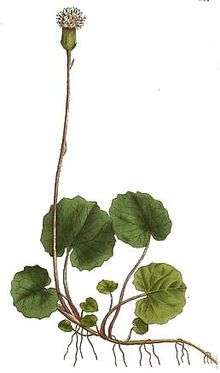Homogyne alpina
| Homogyne alpina | |
|---|---|
 | |
| Scientific classification | |
| Kingdom: | Plantae |
| (unranked): | Angiosperms |
| (unranked): | Eudicots |
| (unranked): | Asterids |
| Order: | Asterales |
| Family: | Asteraceae |
| Tribe: | Senecioneae |
| Genus: | Homogyne |
| Species: | H. alpina |
| Binomial name | |
| Homogyne alpina (L.) Cass. | |
| Synonyms | |
|
Tussilago alpina L. | |
Homogyne alpina, Alpine coltsfoot or purple colt's-foot,[1] is a rhizomatous herb in the Asteraceae family, which is often used as an ornamental plant. In addition, this plant has purple-red flowers, and it is usually associated with the gall flies Ensina sonchi and Acidia cognata.
Homogyne alpina is a perennial plant that reaches a height of 10 to 40 centimeters. The rhizome is creeping woolly and scaly. The stem is erect, reddish brown and often single head. It is hairy silvery-woolly, bare later and usually has 2 leaves on small scales. The leaves are basal, long-stalked, leathery, coarse and glossy dark green, the underside is lighter. The leaf blade is heart-kidney-shaped.
The baskets have a diameter up to 25 mm. The bracts are single row, crowded and hairy brown-red woolly at the base. The flowers are reddish and longer than the basket case, the corners are purple. The fruits have a long hair crown.
Flowering time is from May to August.
Occurrence
Homogyne alpina comes in the mountains of South Central Europe at altitudes from 500 to 3 000 meters. The species grows on moist, humus-rich, mossy soil in coniferous forests, bushes and dwarf-shrub heath. It is common.
Similar Species
The felt-like Homogyne discolor is characterized by the under side white, felty leaves.
References
- ↑ "BSBI List 2007". Botanical Society of Britain and Ireland. Archived from the original (xls) on 2015-02-25. Retrieved 2014-10-17.
- Pink, A. (2004). Gardening for the Million. Project Gutenberg Literary Archive Foundation.
- Xavier Finkenzeller, Jürke Gray: Alpine Flowers (Steinbach nature guide). Mosaic Verlag, Munich 1996, ISBN 3-576-10558-1.
External links
| Wikimedia Commons has media related to Homogyne alpina. |